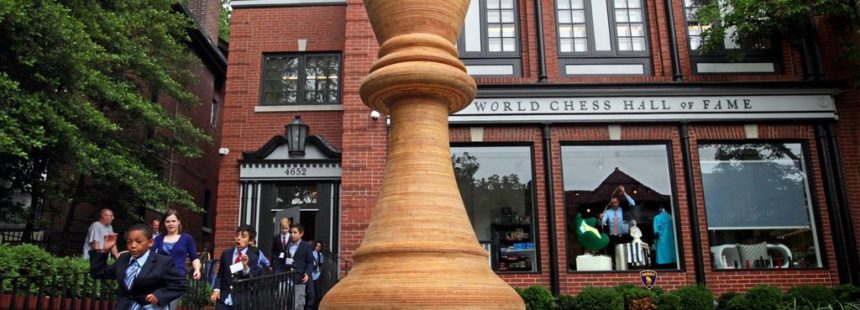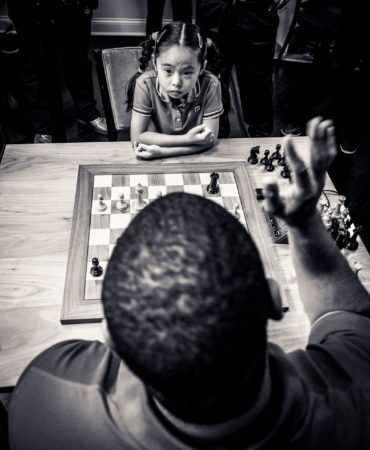

By Garry Kasparov
ORIGINAL ARTICLE AT CHESS HALL OF FAME
 2018 will be an eventful year in the chess world. This November, Magnus Carlsen, the reigning world champion, will defend his crown against Fabiano Caruana, who last week became the first American since Bobby Fischer in 1972 to become the challenger for the undisputed World Chess Championship.
2018 will be an eventful year in the chess world. This November, Magnus Carlsen, the reigning world champion, will defend his crown against Fabiano Caruana, who last week became the first American since Bobby Fischer in 1972 to become the challenger for the undisputed World Chess Championship.
Such a pairing would have sounded fantastical when I was climbing the chess Olympus in the 1980s, back when the mighty Soviet chess machine to which I belonged boasted a majority of the world’s elite players. Consider that Carlsen captured the title from Viswanathan Anand of India in 2013, and now, a Norwegian versus an American! Thanks largely to a generation raised with super-strong chess computers and the internet, chess has become truly global.
Just as remarkably, to the extent that chess has a new center of gravity it is the United States, and in particular, Saint Louis, Missouri. Caruana won the right to challenge Carlsen by winning the Candidates Tournament on March 27, 2018 in Berlin. Among the eight players in that tournament were two Americans: Caruana and Wesley So. Both live in Saint Louis.
Nor is this new, chess-centric Spirit of Saint Louis limited to hosting elite players. The upcoming championship clash will be followed live online by millions of spectators watching a broadcast from Saint Louis. That’s where three superbly entertaining Grandmasters will break down each move from a studio in the basement of the local chess club, a few blocks from Forest Park. These broadcasts have become a way for chess to transcend its small traditional audience, even if my cherished game is not quite ready to compete with the Super Bowl for viewers.
This April, the second floor of the same building will host the U.S. Chess Championships for the 10th consecutive year. Nearly half the participants in the U.S. Chess Championship will be Saint Louisan: Of the top 10 American players, not only Caruana and So but also Ray Robson and Varuzhan Akobian now live there. Top international players also flock to the Gateway City. In August, the world’s best will compete there in the sixth annual Sinquefield Cup, one of the world’s strongest events.
This feast of chess talent is a classic American melting pot. Caruana was born in Miami, learned to play in Brooklyn, and spent most of his teenage years in Europe. So, the current U.S. Champion, was born in the Philippines, Akobian in Armenia, and Robson in Guam. So and Robson both moved to Saint Louis to attend Webster University in Saint Louis’s suburbs, on chess scholarships. Webster’s powerhouse team, coached by the Hungarian-born Grandmaster Susan Polgar, won the U.S. college championship five years running through last year. (Saint Louis University was a credible third in 2017).
How did all of this come to pass? You can work your way back by following the money, but money without passion is often squandered. In this case, it leads you back to a man, and a family, with a remarkable passion for chess.
In 2005, Rex Sinquefield, a Saint Louis native who had made a fortune in the financial services business, moved back home. One of his goals was policy influence; a conservative-libertarian, Sinquefield is now Missouri’s biggest—and therefore most controversial—political donor. But it was a lower-profile Sinquefield project that may turn out to have even longer-lasting influence in Saint Louis and beyond. His goal was to boost the popularity of a game he’d enjoyed since boyhood, chess. Partly he just wanted more of his fellow Saint Louisans to enjoy it. But he also believed, as I do, that the game chess helps instill self-discipline and strategic thinking in young minds.
Sinquefield bought a 6,000 square foot building in an old neighborhood that evokes Washington’s Georgetown and whose residents had once included T.S. Eliot and Tennessee Williams. In July 2008, he reopened the structure as the Chess Club and Scholastic Center of Saint Louis, with plush furnishings, an attractive game room, and a broadcast studio in the basement. Then the club, and the Sinquefields, started to build a chess culture in Saint Louis.
It’s truly a family affair. Rex’s dynamic wife Jeanne was a driving force behind the Boy Scouts of America adding a chess merit badge. Their son Randy runs the state-of-the-art studio that brings the chess world to Saint Louis online. This isn’t just about money, but tremendous dedication and hard work. Instead of looking for a quick splash, they have built a complete system for kids, parents, coaches, and schools. Half a world away from Moscow, Saint Louis is the true heir to the Soviet chess machine. Perhaps this is why it’s the only place I feel comfortable occasionally breaking my retirement vows to test myself at the board—albeit with more enjoyment than sporting success of late.
Today there are chess programs in 140 schools across the metropolitan area, including the public schools in the city and in Ferguson, as well as in several rural districts in central Missouri. The club offers frequent tournaments, group lessons, private lessons, lectures and even summer camps. With more than 1,000 members, it’s now among the world’s largest chess clubs.
Before this Saint Louis chess Renaissance, the United States did not have a suitable venue for world-class tournaments. It didn’t have a deep-pocketed champion who would sponsor a world-class tournament out of his own pocket. It didn’t have programs to attract and develop world-class players capable of producing a gold-medal Olympiad team and a world championship challenger.
Now the U.S. has all of those things—because Saint Louis has all of those things. I wouldn’t say that Rex Sinquefield did it entirely from scratch, however. After all, the first official world chess championship in 1886 included a brief stop in Saint Louis! But if Rex’s master strategy continues to bear fruit, the world chess championship may soon return to his beloved birthplace. It would be a fitting crowning achievement for what has become the chess capital of the world.

